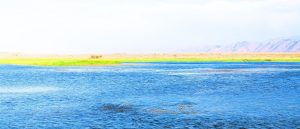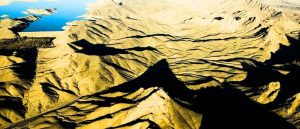Lake Urmia, often referred to as "the turquoise solitaire of Azerbaijan province," is an iconic
and critically important hypersaline lake located in northwestern Iran, nestled between the
provinces of East Azerbaijan and West Azerbaijan. It is the largest lake in Iran and historically
the largest lake in the Middle East and the sixth-largest saltwater lake on Earth. Its unique
ecosystem and significant ecological, economic and social impact have made it a focal point for
environmental concern and restoration efforts.
Geography and Hydrology:
Location: Situated in the Armenian Highlands, west of the southern portion of the
Caspian Sea.
Dimensions: At its greatest extent, it covered an area of approximately 5,200 to 6,000
square kilometers (2,000 to 2,300 sq mi), with a length of about 140 km (87 mi) and a
width of 70 km (43 mi). Its maximum depth is around 16-20 meters (53-66 ft).
Salinity: Lake Urmia is a hypersaline, endorheic (closed basin) lake, meaning it has no
outlet. Its salinity fluctuates significantly with the seasons, ranging from 8-11% in spring
to 26-28% in late autumn, making it about one-fourth as salty as the Dead Sea. The
primary salts are sodium chloride, sulfates, and magnesium.
Water Sources: It is fed by numerous rivers, including the Talkheh (Ājī) River in the
northeast and the Zarineh and Simineh (Tatavi) Rivers in the south. Melted snow from
the Sabalan and Sahand massifs contribute to these rivers.
Division: A causeway, completed in 2008, divides the lake into northern and southern
basins, with a limited water exchange gap, significantly impacting the lake's
hydrodynamics.
Ecology and Biodiversity:
Unique Ecosystem: Despite its extreme salinity, Lake Urmia supports a unique
ecosystem.
Artemia: The lake is a critical habitat for Artemia urmiana, a species of brine shrimp.
These brine shrimps are a vital food source for the lake's abundant bird populations.
Avifauna: Lake Urmia is a significant stopover and breeding ground for migratory birds,
including flamingos, white pelicans, shelducks, and egrets. Historically, tens of
thousands of birds have congregated here.
Flora and Fauna: While fish species cannot survive in its hypersaline waters, the lake is
home to various microorganisms like archaebacteria, bacteria, phytoplankton and
microfungi. The surrounding areas support diverse plant life and terrestrial animals.
UNESCO Designation: Lake Urmia is recognized as a UNESCO Biosphere Reserve and a
Ramsar site, highlighting its global ecological importance.
Historical and Cultural Significance:
Ancient Name: The original Urartian name for the lake was "Urmia" meaning "wavy." It
has historical mentions dating back to the 9th century BCE.
Trade Route: Historically, the lake served as a vital transportation route for trade
between regions.
Therapeutic Properties: The saline waters and mud of Lake Urmia have been believed
to possess therapeutic properties for rheumatological and skin diseases.
The Crisis of Desiccation:
Lake Urmia has faced a severe environmental crisis, dramatically shrinking in size over the past
few decades. This desiccation has profound ecological, economic and social consequences.
Causes:
o Climate Change and Drought: Prolonged periods of drought and rising
temperatures have significantly reduced rainfall and river inflows.
o Unsustainable Water Management: The damming of rivers feeding the lake,
coupled with excessive groundwater extraction for extensive agricultural
irrigation, has drastically reduced water volume.
o Agricultural Expansion: Over the past decades, agricultural land in the basin has
expanded significantly, increasing water demand.
o Causeway Construction: The Urmia Lake Bridge and causeway, while facilitating
transport, have limited water exchange between the basins, exacerbating salinity
issues in some areas.
o Pollution: Industrial and agricultural runoff, often untreated, has further
degraded water quality.
Consequences:
o Ecological Collapse: Loss of habitat for birds and other wildlife, decline in brine
shrimp populations, and disruption of the food web.
o Salt Storms: The drying of the lakebed exposes vast salt pans, leading to salt
storms that degrade air quality, damage agricultural lands, and pose health risks
(respiratory and skin diseases) to local populations.
o Economic Impact: Devastation of the tourism sector, loss of agricultural
productivity due to salinization, and impact on local livelihoods.
o Social and Political Tensions: The crisis has heightened ethnic tensions,
particularly among the Azerbaijani Turk population, whose livelihoods are
intrinsically linked to the lake. Allegations of "ethnic cleansing by environmental
degradation" have emerged due to the displacement and hardship faced by
these communities.
o Land Subsidence: Over-extraction of groundwater contributes to land
subsidence in the region
Restoration Efforts:
Recognizing the severity of the crisis, Iran has initiated efforts to restore Lake Urmia.
Urmia Lake Restoration Program (ULRP): Launched in 2013, this comprehensive
program involves government agencies, research institutions, and international
organizations.
Key Strategies:
o Water Management Reform: Reducing water consumption in agriculture
through improved irrigation efficiency, shifting to less water-intensive crops, and
curbing illegal water usage.
o River Flow Restoration: Managing dam operations to ensure sufficient water
release into the lake.
o Inter-basin Water Transfer: Exploring options for transferring water from other
river basins, such as the Zab River.
o Watershed Management: Implementing measures to protect and restore the
lake's watershed.
o Drought Management: Developing integrated drought management systems.
o Public Awareness and Participation: Engaging local communities in conservation
efforts.
o Funding and International Cooperation: Securing financial resources and
leveraging international expertise, with support from countries like Japan and
organizations like the UNDP and FAO.
Despite these efforts, the restoration process is complex and faces significant challenges,
including funding shortfalls, inter-agency coordination issues, and the persistent impact of
climate change. While some temporary improvements in water levels have been observed due
to favorable rainfall, the long-term sustainability of the lake remains a critical concern. The
situation highlights the intricate link between environmental health, water resource
management, and socio-political stability in the region.

Torshab Lake
Torshab Lake, also known as Tershab, is a Salt Lake located in the Kerman Province of southeastern Iran. It is a seasonal lake, meaning its

Hamun lake
Hamun Lake is a massive and critically important transboundary wetland system located on the border of southeastern Iran (Sistan and Baluchestan Province) and southwestern Afghanistan.

Neor Lake
Neor Lake, situated in the northwestern region of Iran, is a significant natural attraction located on the border between the Gilan and Ardabil provinces. It

Evan Lake
Evan Lake, also known by its Persian name Evan Lake, is a stunning small alpine lake located in the Alamut region of the Alborz Mountain







